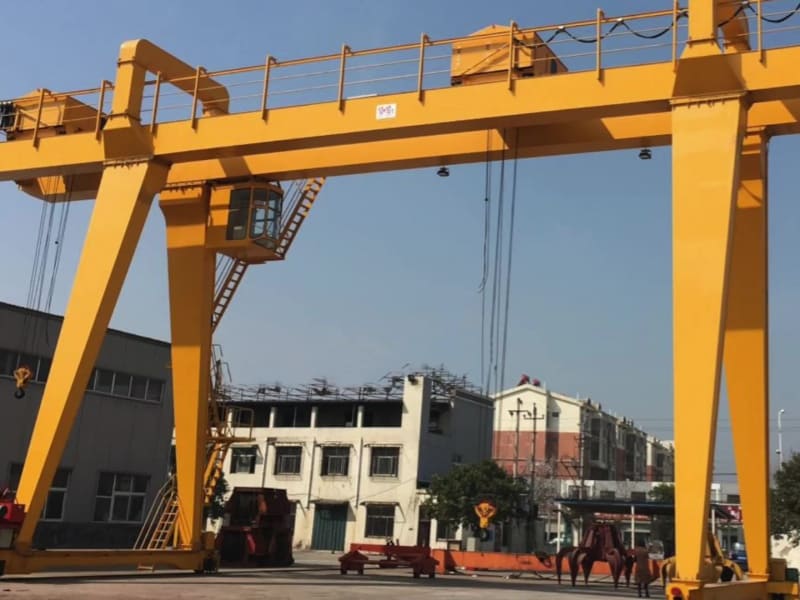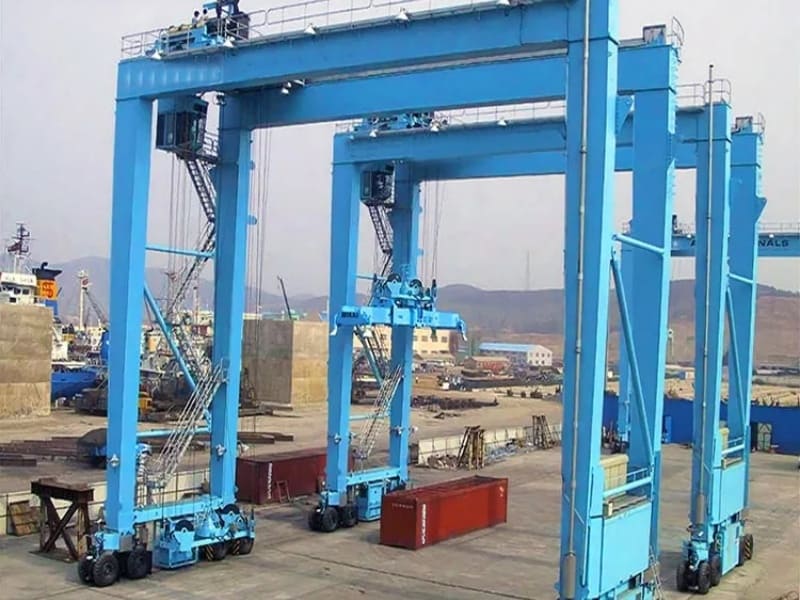Gantry cranes are types of lifting machinery used for outdoor operations in freight yards, stockyards, bulk cargo handling, and similar tasks. Their metal structure resembles a door-shaped frame, which can travel along ground tracks, with the main beam optionally equipped with cantilevers at both ends to increase operational range. Thanks to their stable structure and strong adaptability, gantry cranes are widely applied in ports, railways, factories, and construction sites.
Gantry cranes can be classified in various ways:
By structure: single girder or double girder
By cantilever configuration: single cantilever or double cantilever
By support type: rail-mounted or rubber-tired
By lifting device: hook, grab bucket, or electromagnetic
Double main beam hook gantry crane is a heavy-duty lifting equipment, mainly used for material loading and unloading in ports, cargo yards and other places. Its structure consists of two parallel main beams, outriggers and hooks to form a portal frame. The double-girder design enhances the load-bearing capacity and stability, and is suitable for large-span, heavy-load operating environments. The hook can be raised and lowered vertically and flexibly transport heavy objects. The crane has the characteristics of high efficiency, safety and strong adaptability, and is widely used in industry, logistics and other fields.
The normal use environment of double main beam hook gantry crane should be within the range of -25 ºC ~ + 40 ºC, and the average temperature within 24 hours shall not exceed 35 ºC. It is not easy to work in flammable and explosive media or places with high humidity and corrosive gases. It has a wide range of applications in field work, grabbing materials, factory operations and transportation.
When working in the field, it can work under complex terrain conditions with its strong lifting capacity and stable structure. For example, in large open-pit mines, it can easily lift heavy objects such as ores.
In terms of grabbing materials, whether it is metal materials, wood or prefabricated components,gantry cranes can accurately grab and can be adapted to a variety of lifting equipment to meet different lifting needs.
Inside the factory, it is a key equipment for material handling. From the lifting of raw materials to the processing area to the transfer of finished products to the warehouse, the double main beam hook gantry crane participates in the whole process to ensure a smooth production process.
In the transportation link, in ports, logistics parks and other places, gantry cranes can quickly load and unload goods onto transport vehicles or ships to speed up the turnover of goods.
Features and Lifting Performance of Different Types of Gantry Cranes:
♦Single Girder Gantry Crane: Single girder gantry cranes have a simple structure, relatively light weight, and low equipment and maintenance costs. They are ideal for small sites and low-tonnage operations, such as factories, warehouses, or small docks, with a lifting capacity generally ranging from 5 to 20 tons. Due to their lightweight structure, installation and relocation are relatively easy, and operation is flexible, making them suitable for frequently handling lighter loads. However, their load-bearing capacity is limited, making them less suitable for heavy or continuous high-tonnage operations.
♦Double Girder Gantry Crane: Double girder gantry cranes feature a more complex structure, higher overall weight, and higher equipment and maintenance costs, but provide strong load-bearing capacity. They are suitable for large sites and high-tonnage operations, such as steel mills, cement plants, and coal yards, with a lifting capacity typically ranging from 20 to 500 tons. The double girder structure offers greater stability and safety, supporting larger lifting devices and complex operations, ideal for long-distance handling of heavy materials. Due to their large structure, installation takes longer and site requirements are higher.
♦Rail-Mounted Gantry Crane: Rail-mounted gantry cranes are supported on tracks, providing excellent travel stability and adaptability. They are widely used for outdoor freight yards, stockyards, and bulk cargo handling in ports, power plants, or railway terminals, with lifting capacities generally from 5 to 200 tons. The rail-mounted design ensures smooth operation over long distances, suitable for high-frequency and large-volume material handling. It requires fixed track installation, which demands some site preparation, but within the rail range, operational efficiency and safety are high.
♦Rubber-Tired Gantry Crane: Rubber-tired gantry cranes rely on tires for support, offering flexible mobility and independence from fixed tracks. They can operate on uneven or temporary sites, such as construction areas, bridge projects, or temporary logistics yards, with lifting capacities generally between 10 and 50 tons. The rubber-tired design allows easy relocation and adjustment, suitable for sites with frequently changing work areas. However, movement speed is slower and stability is slightly lower than rail-mounted cranes, requiring careful operation. They are ideal for short-term or multi-site operations and reduce the need for permanent infrastructure.
Each type of gantry crane has unique features and applications. Selecting the right gantry crane requires consideration of lifting capacity, site conditions, handling frequency, and budget. Proper selection and use of gantry cranes can not only improve operational efficiency but also ensure safety and equipment longevity, delivering long-term benefits for businesses.









